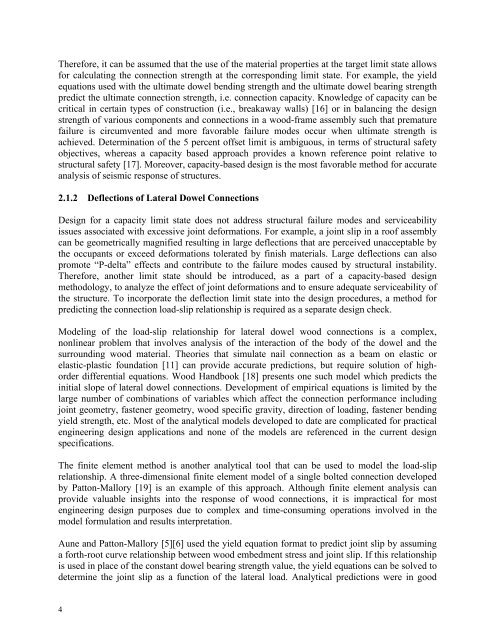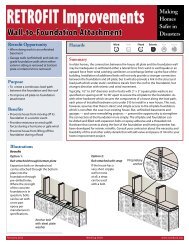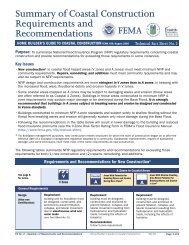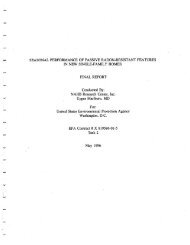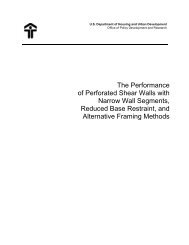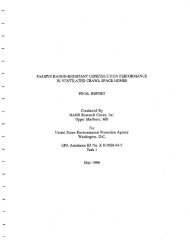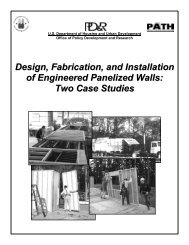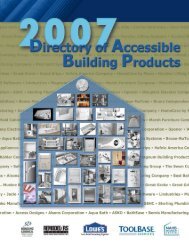roof framing connections in conventional residential construction
roof framing connections in conventional residential construction
roof framing connections in conventional residential construction
You also want an ePaper? Increase the reach of your titles
YUMPU automatically turns print PDFs into web optimized ePapers that Google loves.
Therefore, it can be assumed that the use of the material properties at the target limit state allowsfor calculat<strong>in</strong>g the connection strength at the correspond<strong>in</strong>g limit state. For example, the yieldequations used with the ultimate dowel bend<strong>in</strong>g strength and the ultimate dowel bear<strong>in</strong>g strengthpredict the ultimate connection strength, i.e. connection capacity. Knowledge of capacity can becritical <strong>in</strong> certa<strong>in</strong> types of <strong>construction</strong> (i.e., breakaway walls) [16] or <strong>in</strong> balanc<strong>in</strong>g the designstrength of various components and <strong>connections</strong> <strong>in</strong> a wood-frame assembly such that prematurefailure is circumvented and more favorable failure modes occur when ultimate strength isachieved. Determ<strong>in</strong>ation of the 5 percent offset limit is ambiguous, <strong>in</strong> terms of structural safetyobjectives, whereas a capacity based approach provides a known reference po<strong>in</strong>t relative tostructural safety [17]. Moreover, capacity-based design is the most favorable method for accurateanalysis of seismic response of structures.2.1.2 Deflections of Lateral Dowel ConnectionsDesign for a capacity limit state does not address structural failure modes and serviceabilityissues associated with excessive jo<strong>in</strong>t deformations. For example, a jo<strong>in</strong>t slip <strong>in</strong> a <strong>roof</strong> assemblycan be geometrically magnified result<strong>in</strong>g <strong>in</strong> large deflections that are perceived unacceptable bythe occupants or exceed deformations tolerated by f<strong>in</strong>ish materials. Large deflections can alsopromote “P-delta” effects and contribute to the failure modes caused by structural <strong>in</strong>stability.Therefore, another limit state should be <strong>in</strong>troduced, as a part of a capacity-based designmethodology, to analyze the effect of jo<strong>in</strong>t deformations and to ensure adequate serviceability ofthe structure. To <strong>in</strong>corporate the deflection limit state <strong>in</strong>to the design procedures, a method forpredict<strong>in</strong>g the connection load-slip relationship is required as a separate design check.Model<strong>in</strong>g of the load-slip relationship for lateral dowel wood <strong>connections</strong> is a complex,nonl<strong>in</strong>ear problem that <strong>in</strong>volves analysis of the <strong>in</strong>teraction of the body of the dowel and thesurround<strong>in</strong>g wood material. Theories that simulate nail connection as a beam on elastic orelastic-plastic foundation [11] can provide accurate predictions, but require solution of highorderdifferential equations. Wood Handbook [18] presents one such model which predicts the<strong>in</strong>itial slope of lateral dowel <strong>connections</strong>. Development of empirical equations is limited by thelarge number of comb<strong>in</strong>ations of variables which affect the connection performance <strong>in</strong>clud<strong>in</strong>gjo<strong>in</strong>t geometry, fastener geometry, wood specific gravity, direction of load<strong>in</strong>g, fastener bend<strong>in</strong>gyield strength, etc. Most of the analytical models developed to date are complicated for practicaleng<strong>in</strong>eer<strong>in</strong>g design applications and none of the models are referenced <strong>in</strong> the current designspecifications.The f<strong>in</strong>ite element method is another analytical tool that can be used to model the load-sliprelationship. A three-dimensional f<strong>in</strong>ite element model of a s<strong>in</strong>gle bolted connection developedby Patton-Mallory [19] is an example of this approach. Although f<strong>in</strong>ite element analysis canprovide valuable <strong>in</strong>sights <strong>in</strong>to the response of wood <strong>connections</strong>, it is impractical for mosteng<strong>in</strong>eer<strong>in</strong>g design purposes due to complex and time-consum<strong>in</strong>g operations <strong>in</strong>volved <strong>in</strong> themodel formulation and results <strong>in</strong>terpretation.Aune and Patton-Mallory [5][6] used the yield equation format to predict jo<strong>in</strong>t slip by assum<strong>in</strong>ga forth-root curve relationship between wood embedment stress and jo<strong>in</strong>t slip. If this relationshipis used <strong>in</strong> place of the constant dowel bear<strong>in</strong>g strength value, the yield equations can be solved todeterm<strong>in</strong>e the jo<strong>in</strong>t slip as a function of the lateral load. Analytical predictions were <strong>in</strong> good4


